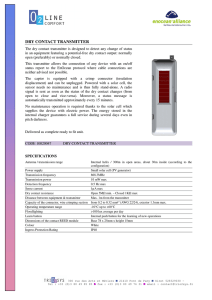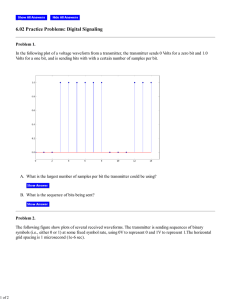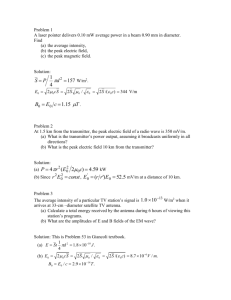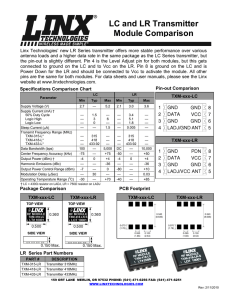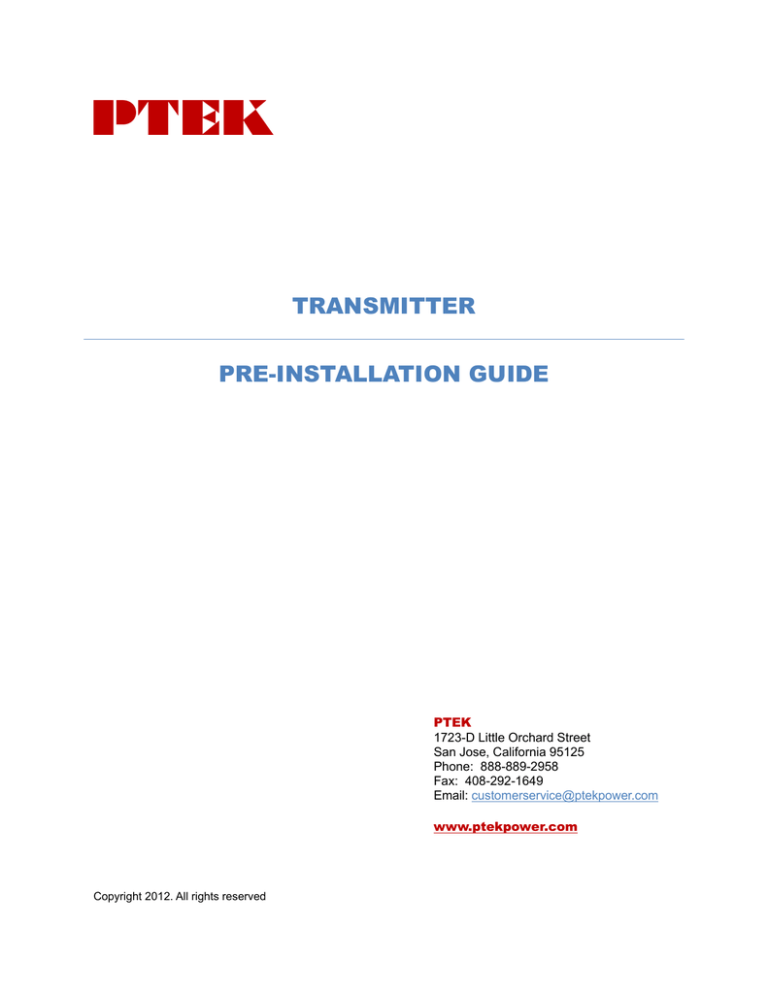
PTEK
TRANSMITTER
PRE-INSTALLATION GUIDE
PTEK 1723-D Little Orchard Street
San Jose, California 95125 Phone: 888-889-2958
Fax: 408-292-1649 Email: customerservice@ptekpower.com
www.ptekpower.com Copyright 2012. All rights reserved The information presented in this document is believed to be
accurate and reliable. It is intended as a guide and to
supplement competent site engineering. If there is a conflict
between the recommendations of this document and local
electrical codes or federal regulations, the requirements of the
local electrical codes and the federal regulations shall have
precedence.
This documentation is subject to change without notice and does
not represent a commitment on the part of PTEK.
No part of this publication may be reproduced, transmitted,
transcribed, stored in a retrieval system, or translated into any
language in any form by any means for any purpose other than
for the purchaser’s personal use without the permission of PTEK.
TABLE OF CONTENTS
1. GENERAL INFORMATION ............................................................................................................................ 1 2. SITE EQUIPMENT CHECK ............................................................................................................................. 1 2.2 COMPONENT LOSS ............................................................................................................................................. 1 2.3 FIELD TEST MEASUREMENTS ............................................................................................................................... 2 2.3.1 ES Series Field Test................................................................................................................................ 2 2.3.2 Gamma Series Field Test ...................................................................................................................... 2 2.4 BACK UP AND STANDBY TRANSMITTER .................................................................................................................. 3 2.5 FCC RULES AND REGULATIONS ............................................................................................................................ 3 3. ELECTRICAL REQUIREMENTS ....................................................................................................................... 4 4. GROUNDING .............................................................................................................................................. 4 4.1 4.2 4.3 4.4 5. LIGHTNING PROTECTION ...................................................................................................................................... 4 POWER LINE SURGES .......................................................................................................................................... 4 ELECTRICAL GROUNDING ..................................................................................................................................... 5 SURGE PROTECTION ........................................................................................................................................... 5 COOLING AND AIR QUALITY........................................................................................................................ 6 5.1 COOLING REQUIREMENTS .................................................................................................................................... 6 Watts to BTU/hour Conversion Table .................................................................................................................... 6 5.2 CLOSED LOOP .................................................................................................................................................... 6 5.3 FORCED AIR ...................................................................................................................................................... 7 5.4 AIR FILTERS ...................................................................................................................................................... 7 6. TRANSMITTER PLACEMENT ........................................................................................................................ 8 7. RACK CABINET MOUNTING ......................................................................................................................... 9 7.1 7.2 8. RACK CABINET GROUNDING ................................................................................................................................. 9 EARTH GROUND ................................................................................................................................................ 9 REMOTE CONTROL ACCESSORY PORT ........................................................................................................ 11 SITE PREPARATION RECOMMENDATIONS 1. GENERAL INFORMATION This guide will assist you in planning and preparing the transmitter site for installation of your new PTEK transmitter. A good transmitter site can ensure many years of reliable performance. A bad site will result in unpredictable or unsatisfactory performance. This document identifies the characteristics of a good site and provides advice on how to achieve these and protect your investment. ES SERIES Output Power (150 to 1000 watts) FM150ES 15W – 165W FM300ES 30W – 330W FM500ES 50W – 550W FM1000ES 100W – 1050W Before installing the PTEK transmitter, there are several pre‐
installation steps that should be completed by qualified personnel only. A Solid State transmitter cannot simply be installed at a transmitter site without completing a thorough audit of the site with possible upgrading in the areas of grounding, lightning protection, air cooling, and air quality, which are discussed in this document. GAMMA SERIES Output Power (1.5kW to 10kW) G1500 150W – 1575W G2000 200W – 2100W G2500 250W – 2625W G3000 300W – 3150W G3500 350W – 3675W G4000 400W – 4200W G5000 500W – 5250W G6000 600W – 6300W G7500 750W ‐ 7875W G10000 1000W – 10500W 2. SITE EQUIPMENT CHECK Transmitters do not work on their own they need other components to facilitate a working system. The RF transmission system consists of the transmitter, a section of coaxial cable and the antenna. The system ‐ from the transmitter flange to the antenna ‐ must be tested before a transmitter is placed in operation. The test must verify the entire system can withstand the expected peak voltages of normal operation without breaking down. Testing should include VSWR, radiation patterns and gain, high power and RF leakage.
2.1 VSWR Sometimes, due to conversions, repairs, or radome installation, the impedance match deteriorates and the antenna needs to be re‐tuned. Typical VSWR should be less than 1.1:1. Anything greater than 5% of the forward power (i.e., 5W for a 100W output) requires attention. If reverse power is higher than 5%, the transmitter’s output power will be reduced to maintain the reverse power at a safe level. If the antenna match worsens, causing reverse power to exceed 10% of the transmitter’s rated power, the transmitter will trip and stop broadcasting. After 45 seconds the unit will attempt to transmit again. If the match is still high enough to generate greater than 10% of the transmitter’s rated power, the unit will trip again. This cycle will be repeated three times. If there is still no improvement in the antenna match, the transmitter will retry every 2 hours. The reflected power needs to be nullified to the smallest reading (1.1:1) by adjusting the antenna according to the manufacturer’s instructions. 2.2 Component Loss Regardless of what system components are specified or used, each one will have signal loss. For example a section of RG/58 coax from a transmitter to the antenna will have cable loss. The dB value is dependent on frequency, cable type and cable length. It is well accepted that all coaxial cable manufacturers publish the nominal attenuation in dB/feet or dB/meter and frequency. RG/58 cable will have a different attenuation loss than a RG/6 cable at the same frequency. Consider the following: 50 Watts transmitter power and using 25’ of RG/58 cable Frequency Cable loss dB Power loss in Watts 100 MHz .95dB 9.83 PTEK Pre Installation Guide P a g e | 1 50 Watts transmitter power and using 25’ of RG/6 cable Frequency Cable loss dB Power loss in Watts 100 MHz .675dB 7.25 This example does not include any connectors or adapters which are notorious for loss. Next look at high power with a mask filter that has a loss of .3dB: Transmitter Power Filter loss Power loss in Watts 25000 .3dB 1720 50000 .3dB 3334 75000 .3dB 5016 These are simple examples showing that minor changes, even those as simple as coaxial cable length or filters, have effects on working transmitters in the field. These components added to a real world environment, are usually not part of a transmitter test at our factory where the original test data was recorded, and transmitter output power was originally set to display on the transmitter metering. This gives rise to the necessity for field power measurements. 2.3 Field Test Measurements 2.3.1 ES Series Field Test A thru‐line wattmeter and a dummy load is a great choice to test the system. The proper way to measure power is to utilize a dummy load, not while broadcasting on the antenna. This ensures the transmitter is terminated in a perfect 50 ohm load. A thru‐line wattmeter can also verify that coax and antenna are in good condition and operating to specification. Some trouble shooting can also be accomplished with the meter. Once the correct element for frequency and rated RF power is selected on the wattmeter, the wattmeter is placed in the transmission path (in‐line) and the forward power out of the transmitter is indicated. By rotating the element in the wattmeter 180 degrees, the meter then displays reflected power. The last step is to nullify the reflected power to the smallest reading by adjusting the antenna according to the manufacturer’s instructions. One of the features of the wattmeter is that it can be left in the transmission line for continuous monitoring of the forward transmitter output power or reflected power from the antenna. Transmitter
Output
OR
Electronics 43 Bird 43
Example shown is Antenna
the Bird Wattmeter Dummy Load
2.3.2 Gamma Series Field Test A rigid‐line wattmeter and a dummy load is the best way to test the high power system. The proper way to measure high power installations is to utilize a dummy load, not while broadcasting on the antenna. This ensures the transmitter is terminated in a perfect 50 ohm load. PTEK Pre Installation Guide P a g e | 2 A rigid‐line wattmeter can also verify that coax and antenna are in good condition and operating to specification. Some trouble shooting can also be accomplished with the meter. Once the correct element for frequency and rated RF power is selected on the rigid‐line wattmeter, the wattmeter is placed in the transmission path (in‐line) and the forward power out of the transmitter is indicated. By rotating the element in the wattmeter 180 degrees, the meter then displays reflected power. The last step is to nullify the reflected power to the smallest reading by adjusting the antenna according to the manufacturer’s instructions. The rigid‐line wattmeter can be left in the transmission line for continuous monitoring of the forward transmitter output power or reflected power from the antenna. Measuring RF power and system match characteristics now can be made, and monitored, in any installation, regardless of the signal waveforms. These measurements can be made while continuously broadcasting without the need to terminate the transmitter in a system dummy load. The FM signal is accurately measured to ensure total power is achieved. This equipment can also alert you via email or Ethernet if a user settable alarm has tripped. Transmitter
Antenna
REV
FWD
Output
OR
Rigid Line
Watt Meter
Dummy Load
Diagram of Rigid‐Line Wattmeter 2.4
Back Up and Standby Transmitter The transmission line leading to the RF switch is a great location in this configuration to place a rigid‐line wattmeter for power measurement. This allows the main transmitter or the standby transmitter to have power monitored while broadcasting and still use the rigid‐line wattmeter if the transmitter is steered to the test load. Often low power radio stations have a backup transmitter when repairs or routine maintenance is required. High power installations most often have a standby transmitter which can be routed through an RF switch or Patch Panel with “U” links. In this way the main transmitter can be broadcasting on the antenna and the standby transmitter can be routed to a dummy or test load. Rotating the switch steers the standby transmitter to the antenna and then the main transmitter is routed to the dummy load for service, repair or routine testing. 2.5
FCC Rules and Regulations The FCC issues guidelines which specify power output tolerances. Depending on the license of the end user it can specify a window of operation. In other words you must operate at 100% power +/‐ a certain percentage of power. The FCC even has the power to levy fines if the transmitting system is out of its rated licensed operating power. In most cases it will be less expensive to verify RF power measurements than to take any chance of operating outside the limits of the license. The FCC also requires a verification which necessitates field power measurements to be taken, recorded and reports to be filed stating that all of the guidelines are being met. PTEK Pre Installation Guide P a g e | 3 3. ELECTRICAL REQUIREMENTS Product AC Voltage AC Connector Cord Supplied AC Current (trip rating) ES Series 50 to 500W 88‐264VAC Nema C13 C13 to 5‐15P 15A 1000W 200‐264VAC Nema C13 C13 to pig tails 15A Gamma Series 1,500 to 3,000 watts 88‐264VAC IEC320 C19 C19 to pig tails 20A 3,500 to 4,000 watts 200‐264VAC AMP‐206036‐2 AMP to pig tails 40A In the transmitters below each power amplifier has a separate AC input. The transmitter is supplied with the appropriate AC cord for each power amplifier. Product AC Voltage AC Connector Cord Supplied AC Current (trip rating) Gamma Series 5,000 to 6,000 watts 200‐264VAC IEC320 C19 two C19 to pig tails 2X20A 7,500 watts 200‐264VAC AMP‐206036‐2 two AMP to pig tails 2X40A 4. GROUNDING devices at the antenna and on the wiring entering the transmitter cabinet, which will divert energy away from the transmitter. The ground system should include substantial grounding of tower guy wires (at each anchor point) and each tower leg using 8‐10 foot copper ground rods. Ensure the power company has provided proper grounding of the AC mains power at the site as well. Proper grounding is an essential component for safely and reliably operating your transmitter. Improper grounding has the potential to bring disastrous results from both an operational as well as a safety standpoint. A solid state transmitter's internal protection circuits/devices are not able to protect the transmitter from damage as the result of a direct lightning hit via the power line or tower connections. They must be supplemented by additional protection 4.1 Lightning Protection Lightning will cause the greatest damage to broadcast equipment. Lightning will strike the highest object and will take the path of least resistance on its way to ground. A broadcast tower is an attractive target. Steps need to be taken to mitigate damage from lightning strikes to the tower. Install an ionization dissipater at the top of the tower. This is an array of multiple sharp steel points, connected to ground by a substantial conducting cable. The sharp points will attract the ionized air particles, drawing the charge out of the air in the area surrounding the point. There is a limit to how much current each point can draw, and so to make it more effective, many points need to be installed. 4.2 Power Line Surges service provider to maintain stable voltages at all times, and must take reasonable precautions to protect the sensitive equipment from the vagaries of the power grid. Fortunately, a wide variety of AC transient protection devices are available on the market today, which, when properly installed, can greatly reduce the incidence of power‐caused transmitter damage. Another major source of damage to solid state transmitters is power line voltage instability. Line voltages are extremely unstable, particularly after a power outage causing voltage transients and surges even when the outage is many miles away. These voltage surges and transients can cause damage to power supply components of broadcast transmitters and can also damage other circuitry beyond the power supply. Broadcasters cannot rely on the power PTEK Pre Installation Guide P a g e | 4 4.3 Electrical Grounding The single point grounding system is commonly used in broadcasting. In a single point ground system there is one common or star point where all grounds join together at a single point. This point is often a selected point along a ground system that encircles the building using copper strap and multiple ground rods not closer than ten feet. Usually four ground rods connected with four inch copper strap spaced around the tower will be required; however, the number of ground rods will depend on soil conductivity and the size of the building. Round conductors have approximately the same inductance regardless of size. Wide flat copper strap should be used to reduce the ground conductor inductance. If the soil conductivity is poor, it may be necessary to install a counter pose system much like that used for ground systems. strap, this ground should be tied to the outside star point and the AC mains ground should be connected to the star point. All coaxial cables should enter and exit the building at a single entry point and their shield(s) should be connected to a ground plate, which is then connected to the star point. The net result of not employing star point grounding is increased vulnerability. It is recommended a single connection point to the station reference ground be established, preferably where the AC power wiring and the RF feed's coaxial cable enter the transmitter building. The purpose of this ground is to prevent ground loops and to ensure unwanted currents do not flow into the transmitter cabinet. The shield of the RF feed cable, the AC power ground, the ground return for the AC power suppression system and the transmitter's reference ground point should all be individually connected to this point; by insulated, low inductance, low impedance, ground straps. The interior of the building should have a common ground system made up of 2 or 4 inch copper ground 4.4 Surge Protection areas external surge protection will be required. Many are available for broadcasting use. However, the transmitter and other site equipment are best protected by a transient voltage surge suppressor (TVSS). The TVSS should be connected at the site’s AC mains entrance and connected to ground using a copper ground strap in addition to the standard ground wire provided by your electrician. There are many levels of TVSS protection that can be employed depending on the condition of the source power. Staying On Air depends on management of power surges, transients and anomalies. In less than a second an unprotected transmitter can easily be compromised, giving rise to the need for Surge Protection Devices making surge protection an important component of any transmission system. PTEK power supplies are equipped with built‐in surge protection which is one level of protection for the transmitter. However for overhead power lines in rural PTEK Pre Installation Guide P a g e | 5 5. COOLING AND AIR QUALITY The best way to protect your transmitter investment is to maintain correct operating temperatures and keep its interior clean. PTEK transmitters are designed to operate in an environment with an intake air temperature between 32ᵒF and 85ᵒF with ideal temperature being 68ᵒF. The transmitter’s air system is designed to supply sufficient air at the required static pressure to cool the transmitter only. Additional pressure losses introduced by exhaust systems and air supply duct work must be offset by means other than the transmitter fans. These inlet and exhaust system ducts generally need to be installed with helper fans to offset these losses. It is recommended that the station consult with an HVAC specialist to determine the requirements of intake and exhaust ducts in order to meet the flow volumes required by the transmitter. Outside air which contains salt or pollution must have those items removed by an adequate filtration system or a closed system must be used.
5.1 Cooling Requirements The capacity of air conditioners (and furnaces) is given in BTUs per hour. You will need to establish the correct cooling required in BTUs per square foot for your transmitter building. At a bare minimum, you will need approximately 40‐50 BTUs per square foot and multiply this by the total footage to be cooled, but this does not take into account climate or insulation. For example, 100‐150 square feet will need 5,000 BTUs per hour. Take into account that a transmitter will generate heat equal to its output power. See Table below. The number calculated tells how much heat builds up in the room each hour. The air conditioner’s cooling capacity (BTU/hour) should nearly match the resulting number. A difference of about 5 percent between the number calculated and the air conditioner should not be significant. Watts to BTU/hour Conversion Table Power (watt)
Power (BTU/hour)
1 W 3.412142 BTU/hour
10 W 34.121420 BTU/hour
100 W
341.214200 BTU/hour
1000 W
3412.142000 BTU/hour
10000 W
34121.420000 BTU/hour
5.2 Closed Loop To minimize contamination problems and guarantee the optimum operating temperature, closed loop air conditioners are highly recommended. These systems circulate the air in the transmitter building via an evaporator; the coolant used in the evaporator is then cooled outside in a condenser. This ensures that the dirty and or contaminated outside air does not mix with the clean indoor air, used to cool the transmitter. PTEK Pre Installation Guide P a g e | 6 5.3 Forced Air When transmitter cooling is entirely by forced air, external fans are used to circulate air from the outside into the transmitter building and are then exhausted outside. It is important to make sure the fans provide much more air circulation that the transmitter fan and that the inside building temperature does not exceed the transmitter inlet temperature (68oF for longevity). It is essential that the air drawn into the transmitter building is adequately filtered and that the filter is regularly maintained. Transmitter
Front
Rear
Exhaust
Air
Intake
Air Fliter
Exhaust
Fan
Transmitter Building
5.4 Air Filters Air filters require cleaning or replacement but the interval depends on conditions at the site and must be determined by site personnel. The transmitters have over temperature detectors, but prolonged operation at high temperature will degrade reliability. A periodic check of the inlet to outlet temperature rise is a convenient way to detect a decrease in cooling due to filter clogging, without the need for visual inspection. Dirt is the number one enemy of solid‐state transmitters and a properly designed cooling system with adequate filtering is very important. The situation at the actual site will dictate the kind of filtering needed. Some areas may be plagued with fine sand while others have insect problems. Even with all this we have seen sites with 2 cm of flies on the transmitter floor after only 6 months and other sites with the air inlets and outlets reversed. PTEK Pre Installation Guide P a g e | 7 6. TRANSMITTER PLACEMENT The transmitter will require a level surface to rest on. If the transmitter is not on a level surface make sure it is leveled and stable before continuing the installation. The transmitter should be placed with AC power and signal connections in mind. The sidewalls of the FM transmitter may be placed against a wall or other equipment, access to the sides of the transmitter is not required. Complete access is through the front and rear of the transmitter. The floor must be capable of supporting a load of 250 pounds per‐square‐foot (1221 kg per‐square‐meter). The power supplies roll out the front of the transmitter for system maintenance. Therefore, the transmitter should not be set up on 4X4 blocks or similar supports. Be sure to have a smooth flat surface in front of the transmitter of at least 36 inches for maintenance. Transmitter Placement
Other equipment
36” Minimum
Transmitter
24”
24” Minimum
36”
Other equipment
Transmitter Building
PTEK Pre Installation Guide P a g e | 8 7. RACK CABINET MOUNTING The recommended mounting of an ES Series transmitter in a rack cabinet is by attaching rack slides (available for purchase) or a rack shelf. It is not recommended that you use 4 front panel screws to attach to the rack cabinet. Under no circumstances should a Gamma Series transmitter be mounted in a rack with the front panel screws only. This will damage the unit and void the warranty. Rack slides or a rack shelf must be used. 7.1 Rack Cabinet Grounding The single point grounding technique can also be effective to protect multiple pieces of equipment installed inside an equipment rack cabinet. Treat the rack the same as you would a building, and ground all conductors entering and leaving the rack. Install AC surge protectors at this point in shunt to ground, and install a series impedance between the rack and the equipment. Don’t count on the metal cabinet itself to serve as a ground conductor – paint and oxidation may prevent a good connection. A copper strap should be run along the inside of the cabinet, bonded to the cabinet along its length. The chassis of each piece of equipment is then bonded to this buss bar with a single copper braid or strap. Redundant ground connections by means of the AC cable and the shields of audio cables should be avoided when possible. Finally, connect the rack to the building reference ground. 7.2 Earth Ground Once all connections have been made to the master ground point in the building, it must be bonded to an effective earth ground system outside the building. Four‐inch or larger copper strap of #2 AWG multi‐
strand wire is recommended, with short, straight connections. Corrosion will dramatically increase the resistance of a connection, so use silver soldering for all connections exposed to the weather. A network of four or more 10‐foot ground rods driven at least 20 feet apart makes the best earth‐ground interface. A commonly used earth grounding method for transmitter buildings is the perimeter ground, where a conductor is run around the base of a building and bonded to ground rods spaced at even intervals around the building. (See Section 4 Grounding, above) In a large building containing several independent systems inside, each system can have its own reference ground established, which is in turn connected to the perimeter ground at the closest point. This method avoids long runs of ground strap inside the building. It’s important that any ground connections between these separate systems be avoided, and torroids or surge arrestors be installed on any interconnections which could not be avoided. PTEK Pre Installation Guide P a g e | 9 PTEK Pre Installation Guide P a g e | 10 8. REMOTE CONTROL ACCESSORY PORT The rear I/O Panel provides a 25‐pin male DB25 connector as an accessory‐port interface. A pin out is provided below; signal descriptions are as defined in the table or refer to our Product Manual. PTEK Pre Installation Guide P a g e | 11

